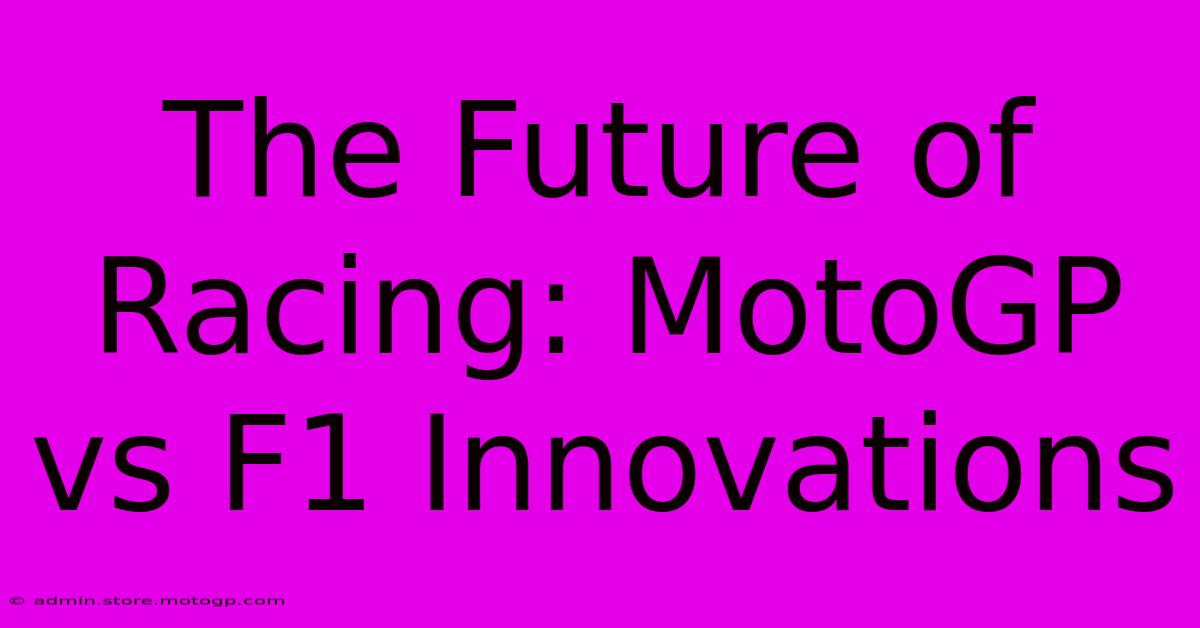The Future Of Racing: MotoGP Vs F1 Innovations

Table of Contents
The Future of Racing: MotoGP vs F1 Innovations
The roar of the engines, the breathtaking speeds, the nail-biting finishes – motorsport continues to captivate audiences worldwide. But the future of racing isn't just about faster laps; it's about innovation. This article dives into the exciting technological advancements and strategic shifts shaping the future of two titans of motorsport: MotoGP and Formula 1. We'll explore how these series are pushing the boundaries of engineering and sustainability, creating a thrilling spectacle for years to come.
The Electrifying Shift: Sustainability in Motorsport
Both MotoGP and F1 are acknowledging the growing pressure for sustainable practices. While the immediate future still relies on combustion engines, the long-term vision involves significant changes.
F1's Green Initiatives:
- Sustainable Fuels: F1 is heavily investing in the development and implementation of sustainable fuels, aiming for 100% sustainable fuel by 2026. This represents a huge leap towards reducing the carbon footprint of the sport.
- Engine Regulations: Stricter engine regulations are continuously being implemented to improve fuel efficiency and reduce emissions. The focus is on hybrid power units, maximizing energy recovery and minimizing waste.
- Lightweight Materials: The use of lightweight, sustainable materials in car construction is gaining traction, further contributing to improved performance and reduced environmental impact.
MotoGP's Green Journey:
- E-Fuel Exploration: While the transition is slower than in F1, MotoGP is exploring the potential of e-fuels and alternative energy sources to reduce its environmental impact.
- Improved Engine Efficiency: Similar to F1, MotoGP is constantly refining engine technology to optimize fuel efficiency and reduce emissions, albeit at a slower pace.
- Tire Sustainability: The development of more sustainable tire compounds and waste reduction strategies is an ongoing area of focus for MotoGP.
Technological Advancements: Pushing the Boundaries of Performance
Beyond sustainability, both MotoGP and F1 are relentless in their pursuit of technological advancement to enhance performance and spectator experience.
F1's Technological Edge:
- Aerodynamics: F1 continuously refines aerodynamics, with teams constantly innovating to reduce drag and maximize downforce. This leads to faster lap times and improved handling.
- Artificial Intelligence (AI): AI plays an increasingly crucial role in F1, from optimizing car setups to analyzing race data in real-time, enhancing strategic decision-making.
- Advanced Materials: The use of cutting-edge materials like carbon fiber composites allows for lighter, stronger, and more aerodynamic cars.
MotoGP's Technological Prowess:
- Electronics and Traction Control: MotoGP bikes are sophisticated machines incorporating advanced electronics and traction control systems, allowing riders to push the limits of performance while maintaining control.
- Aerodynamics: Although less pronounced than in F1, MotoGP is also making strides in aerodynamics, with winglets and other aerodynamic aids contributing to improved stability and cornering speeds.
- Tire Technology: The development of high-performance tires plays a critical role in MotoGP, with manufacturers constantly striving to improve grip, durability, and consistency.
The Future of the Fan Experience: Immersive Entertainment
Both series recognize the importance of engaging fans and enhancing the viewing experience.
F1's Immersive Strategies:
- Virtual Reality (VR) and Augmented Reality (AR): F1 is embracing VR and AR technologies to offer fans immersive experiences, bringing them closer to the action.
- Data-Driven Insights: Real-time data analysis and visualization provide fans with deeper insights into the race strategy and performance of their favorite drivers.
- Fan Engagement Platforms: F1 is leveraging social media and digital platforms to foster a stronger connection with fans worldwide.
MotoGP's Fan Engagement:
- Enhanced Broadcasting: MotoGP is continually improving its broadcast coverage, incorporating innovative camera angles and graphics to enhance the viewing experience.
- Rider Interaction: Increased opportunities for fans to interact with riders through social media and other channels strengthen the fan-rider connection.
- Accessibility: MotoGP is working to make the sport more accessible to a wider audience through diverse broadcasting options and fan engagement initiatives.
Conclusion: A Thrilling Race to the Future
The future of racing is dynamic, exciting, and driven by innovation. Both MotoGP and F1 are embracing technological advancements and sustainability initiatives, creating a thrilling spectacle for fans globally. The competition between these two iconic motorsport series will undoubtedly continue to push the boundaries of engineering, performance, and entertainment for many years to come. The race is on, and the future looks electrifying!

Thank you for visiting our website wich cover about The Future Of Racing: MotoGP Vs F1 Innovations. We hope the information provided has been useful to you. Feel free to contact us if you have any questions or need further assistance. See you next time and dont miss to bookmark.
Featured Posts
-
Yamaha Moto Gp Inspiring The Next Generation
Feb 17, 2025
-
Austin Gp 2025 A High Octane Adventure
Feb 17, 2025
-
F1 Starting Grid The Key To A Winning Strategy
Feb 17, 2025
-
Cota Lot H Your Complete Guide
Feb 17, 2025
-
F1 Shuttles The Insiders Guide To Race Day
Feb 17, 2025
